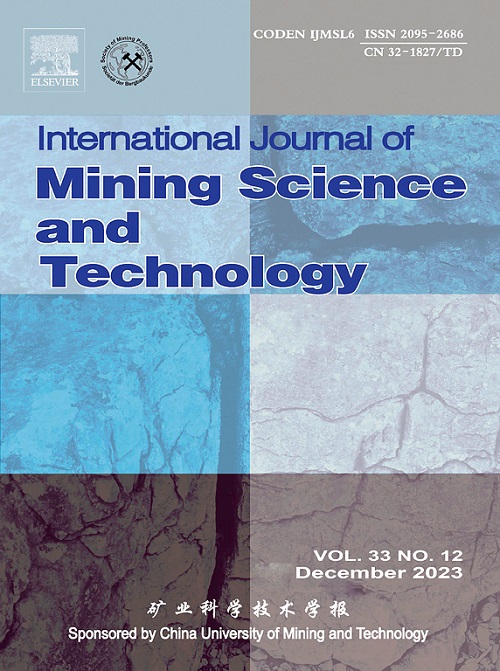钢渣、粒状高炉渣、脱硫石膏在高掺量钢渣基胶凝回填材料中的协同作用机理
IF 13.7
1区 工程技术
Q1 MINING & MINERAL PROCESSING
International Journal of Mining Science and Technology
Pub Date : 2025-06-01
DOI:10.1016/j.ijmst.2025.05.007
引用次数: 0
摘要
在钢渣基矿山充填胶凝材料体系中,钢渣(SS)、粒状高炉渣(GBFS)和脱硫石膏(DG)的水化反应机理和协同效应是优化和调控钢渣基矿山充填胶凝材料性能的关键。然而,现有研究尚未充分揭示其潜在的协同机制,这限制了高SS含量在矿山充填体和低碳建材中的应用和推广。本研究通过多尺度表征技术,系统探索了基于ss的胶凝体系中各种固体废物之间的协同效应及其对水化过程的调控。结果表明:GBFS通过释放活性Si4+和Al3+,与SS提供的Ca2+协同活化,促进了C-S-H凝胶和钙矾石的形成,显著优化了硬化膏体的微观结构。当GBFS含量达到30%时,C-S-H含量增加40.8%,孔隙尺寸分布改善,大孔隙比例减少68.7%,90天抗压强度提高到基线组的5倍。DG的硫酸盐活化作用加速了硅酸盐矿物的水化作用,但过量掺入(>16%)会导致AFt晶体膨胀产生微裂纹,从而导致强度降低。在8% DG和30% GBFS的协同作用下,水化反应最为强烈,峰值放热速率达到0.92 mW/g,累计放热量为240 J/g。通过构建“SS-GBFS-DG-水泥”四元协同体系(质量比范围:SS:GBFS:水泥:DG=(50-62):(20-40):10:(8-12)),优化了高含量SS体系中活性组分的匹配,显著改善了微观结构缺陷,满足了工程应用要求。本研究为高含量ss基胶凝材料的组份设计和性能调控提供了理论依据。本文章由计算机程序翻译,如有差异,请以英文原文为准。
Synergistic mechanisms of steel slag, granulated blast furnace slag, and desulfurization gypsum in high-content steel slag-based cementitious backfill materials
In the steel slag-based mine backfill cementitious material systems, the hydration reaction mechanisms and synergistic effects of steel slag (SS), granulated blast furnace slag (GBFS), and desulfurization gypsum (DG) are crucial for performance optimization and regulation. However, existing studies have yet to fully reveal the underlying synergistic mechanisms, which limits the application and promotion of high SS content in mine backfill and low-carbon building materials. This study systematically explores the synergistic effects between various solid wastes and their regulation of the hydration process in the SS-based cementitious system through multi-scale characterization techniques. The results show that GBFS, by releasing active Si4+ and Al3+, triggers a synergistic activation effect with Ca2+ provided by SS, promoting the formation of C-S-H gel and ettringite, significantly optimizing the hardened paste microstructure. When the GBFS content reaches 30%, the C-S-H content increases by 40.8%, the pore size distribution improves, the proportion of large pores decreases by 68.7%, and the 90-day compressive strength increases to 5 times that of the baseline group. The sulfate activation effect of DG accelerates the hydration of silicate minerals, but excessive incorporation (>16%) can lead to microcracks caused by the expansion of AFt crystals, resulting in a strength reduction. Under the synergistic effect of 8% DG and 30% GBFS, the hydration reaction is most intense, with the peak heat release rate reaching 0.92 mW/g and the cumulative heat release amount being 240 J/g. By constructing a “SS-GBFS-DG-cement” quaternary synergistic system (mass ratio range: SS:GBFS:cement:DG=(50–62):(20–40):10:(8–12)), the matching of active components in high-content SS systems was optimized, significantly improving microstructural defects and meeting engineering application requirements. This study provides a theoretical basis for the component design and performance regulation of high-content SS-based cementitious materials.
求助全文
通过发布文献求助,成功后即可免费获取论文全文。
去求助
来源期刊

International Journal of Mining Science and Technology
Earth and Planetary Sciences-Geotechnical Engineering and Engineering Geology
CiteScore
19.10
自引率
11.90%
发文量
2541
审稿时长
44 days
期刊介绍:
The International Journal of Mining Science and Technology, founded in 1990 as the Journal of China University of Mining and Technology, is a monthly English-language journal. It publishes original research papers and high-quality reviews that explore the latest advancements in theories, methodologies, and applications within the realm of mining sciences and technologies. The journal serves as an international exchange forum for readers and authors worldwide involved in mining sciences and technologies. All papers undergo a peer-review process and meticulous editing by specialists and authorities, with the entire submission-to-publication process conducted electronically.
 求助内容:
求助内容: 应助结果提醒方式:
应助结果提醒方式:


